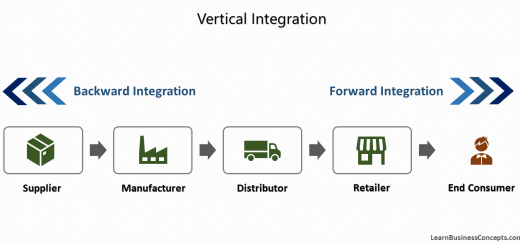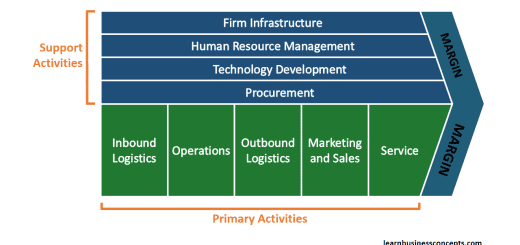Difference of Vertical Integration & Horizontal Integration
What is Vertical Integration?
Vertical integration occurs when a company gains control of more than one stage of the supply chain. The goal of vertical integration is to expand and gain control of the entire supply chain. It refers to the process of taking control of one or more stages in the value chain by acquiring or starting a business within the same production vertical.
Companies achieve vertical integration in two ways.
- Take ownership and control of more than one stage of the supply chain. This means getting control of business activities that are behind in the company’s value chain. To move backward to raw materials production.
- Take ownership and control of more than one stage of the distribution chain. Simply this means getting control of business activities that are ahead in the company’s value chain. To move forward toward the end consumer.
The company can either choose one of the above options or can choose both options to move forward with the vertical integration.
What is Horizontal Integration?
Horizontal integration is where two companies in the same industry merge with each other. Competitor companies in the same industry get together to achieve economies of scale and higher market share. Horizontal integration occurs within the same industry so that the entities involved can enhance their competencies together.
The company will be able to explore new market segments, achieve economies of scale, eliminate competition, increase efficiency, and optimize production capabilities as a result of horizontal integration.
The company can proceed with Horizontal Integration in a form of mergers and acquisitions. A merger is where two companies combine to move ahead as one company. An acquisition is where one company purchases another company to expand its business. These will help the company to strengthen its position in the industry.
Difference between Vertical Integration & Horizontal Integration
The difference between Vertical Integration & Horizontal Integration is explained in the below table,
| Vertical Integration | Horizontal Integration |
|---|---|
| The company obtains the ownership and control of more than one stage of the supply chain | Two companies in the same industry and same stage of the supply chain merge |
| Used to move forward to the end consumer, or else, move backward to raw materials production. | Used to strengthen its position in the industry and increase market share. |
| The goal of vertical integration is to expand and gain control of the entire supply chain. | The goal of horizontal integration is that the entities involved can enhance their competencies together. |
| Successful synergies depend on the company’s mutual understanding of how will both companies need to progress through their share of the supply chain. | Successful synergies depend on the consolidated strategic business activities and processes of companies |
| Can result in a lack of flexibility to respond when market trends change. This is due to the dependency of the value chain, which is strongly linked together. | Can result in reduced flexibility because the consolidated company had become a larger organization and never materialized synergies. |
Comparison of Vertical Integration vs Horizontal Integration,
1) In Vertical Integration, the company obtains the ownership and control of more than one stage of the supply chain.
But in Horizontal Integration, two companies in the same industry and same stage of the supply chain merge.
2) Vertical Integration can be to move forward to the end consumer, or else, move backward to raw materials production.
Horizontal Integration used to strengthen its position in the industry and increase market share.
3) The goal of vertical integration is to expand and gain control of the entire supply chain.
The goal of horizontal integration is that the entities involved can enhance their competencies together.
4) Successful synergies of vertical integration depend on the company’s mutual understanding of how will both companies need to progress through their share of the supply chain.
Successful synergies of horizontal integration depend on the consolidated strategic business activities and processes of companies
5) Vertical Integration can result in a lack of flexibility to respond when market trends change. This is due to the dependency of the value chain, which is strongly linked together.
Horizontal Integration can result in reduced flexibility because the consolidated company had become a larger organization and never materialized synergies.
Recommended Articles:
- Vertical Integration


